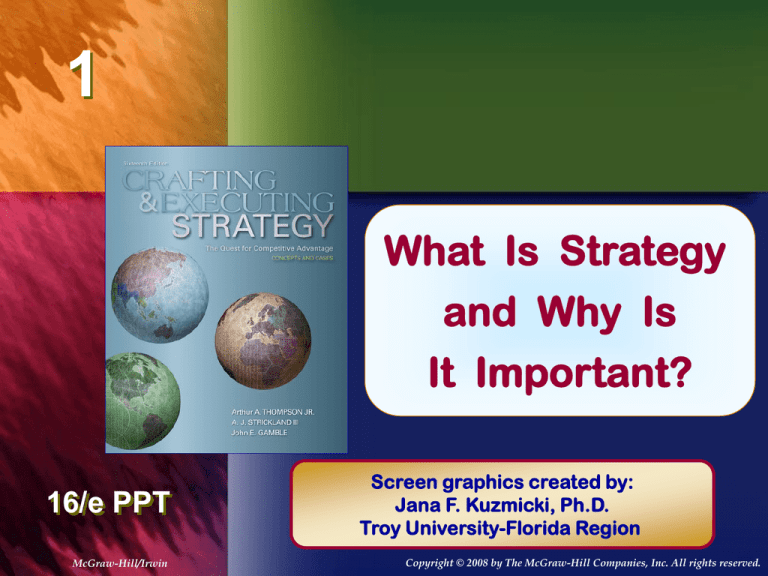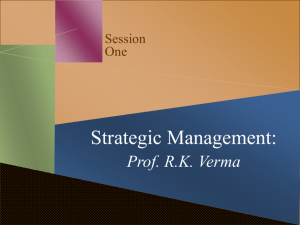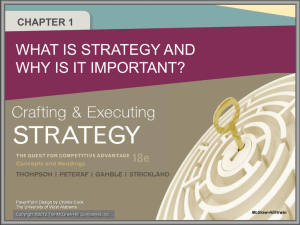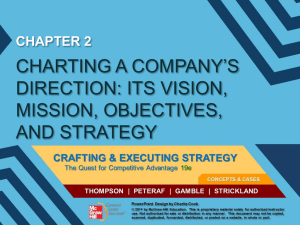
1
What
Is Strategy
Chapter
Title
and Why Is
It Important?
16/e PPT
McGraw-Hill/Irwin
Screen graphics created by:
Jana F. Kuzmicki, Ph.D.
Troy University-Florida Region
Copyright © 2008 by The McGraw-Hill Companies, Inc. All rights reserved.
“Without a strategy the
organization is like a
ship without a rudder.”
Joel Ross and Michael Kami
1-2
Chapter Roadmap
What Do We Mean By Strategy?
Strategy and the Quest for Competitive Advantage
Identifying a Company’s Strategy
Why a Company’s Strategy Evolves Over Time
A Company’s Strategy Is Partly Proactive and Partly Reactive
Strategy and Ethics: Passing the Test of Moral Scrutiny
The Relationship Between a Company’s Strategy and Its
Business Model
What Makes a Strategy a Winner?
Why Are Crafting and Executing Strategy Important?
1-3
Thinking Strategically:
The Three Big Strategic Questions
1. What’s the company’s present situation?
2. Where does the company need to go from here?
Business(es)
Buyer
to be in and market positions to stake out
needs and groups to serve
Direction
to head
3. How should it get there?
A company’s
answer to “how
will we get there?” is its strategy
1-4
What Do We Mean By “Strategy”?
Consists
of competitive moves and business
approaches used by managers to run the
company
Management’s
“action plan” to
Grow the business
Attract and please customers
Compete successfully
Conduct operations
Achieve target levels of
organizational performance
1-5
The Hows That
Define a Firm's Strategy
How
to grow the business
How
to please customers
How
to outcompete rivals
Strategy
is HOW
to . . .
How
to manage each functional
piece of the business (R&D, production, marketing,
HR, finance, and so on)
How
to respond to changing market conditions
How
to achieve targeted levels of performance
1-6
Choosing the “Hows” of Strategy
Strategic choices about “how” are based on
Trial-and-error organizational learning about what has worked and
what has not worked
Management’s appetite for taking risks
Managerial analysis and strategic thinking about how best to
proceed, given market conditions and the company’s circumstances
In choosing a strategy, management is in effect saying,
“Among all the many different business approaches and
ways of competing we could have chosen, we have
decided to employ this particular combination of
competitive and operating approaches in moving the
company in the intended direction, strengthening its
market position, and competitiveness, and boosting
performance.”
1-7
Key Elements of a Successful Strategy
Developing a successful strategy hinges on making
competitive moves aimed at
Appealing to buyers in ways to set the enterprise apart from
rivals and
Carving out its own market position
Involves developing a distinctive “aha”
element to
Attract customers and
Produce a competitive edge
Copying competitive moves of other
successful companies rarely works!
1-8
Key Elements:
Comcast’s Strategy
Roll out high-speed Internet or broadband service to customers via
cable modems
Promote a new video-on-demand service to allow digital
subscribers to watch TV programs whenever they want
Promote a video-on-demand service so digital customers can order
and watch pay-per-view movies
Partner with Sony, MGM, and others to expand movie offerings
Use VoIP technology to offer subscribers Internet-based phone
service at a fraction of the cost charged by others
Use video-on-demand and CDV offerings to combat mounting
competition from satellite TV providers
Employ a sales force to sell advertising to businesses that were
shifting advertising dollars from sponsoring network programs to
sponsoring cable programs
Significantly improve customer service
1-9
For Discussion: Your Opinion
From your perspective as a cable or satellite service
consumer, does Comcast’s strategy (as described in
Illustration Capsule 1.1) seem to be well-matched to
industry and competitive conditions?
Does the strategy seem to be keyed to a cost
advantage, differentiating features, serving the unique
needs of a niche, or developing resource strengths and
competitive capabilities rivals can’t imitate or trump (or a
mixture of these)?
What is there about Comcast’s strategy that can lead to
sustainable competitive advantage?
1-10
Strategy and the Quest for
Competitive Advantage
The
heart and soul of any strategy are the actions
and moves in the marketplace that a company
makes to strengthen its competitive position and
gain a competitive advantage over rivals
A creative distinctive strategy that sets a company
apart from rivals and yields a competitive
advantage is a company’s most reliable ticket to
above average profitability
Competing with a competitive advantage is more
profitable than competing with no advantage
Competing with a competitive disadvantage nearly
always results in below-average profitability
1-11
A Powerful Strategy Leads to
Sustainable Competitive Advantage
A company achieves sustainable competitive advantage
when an attractive number or buyers prefer its
products/services over those of rivals and when the basis
for this preference can be maintained over time
Its nice when a strategy produces a temporary
competitive edge but a durable edge over rivals greatly
enhances a company’s prospects for winning in the
marketplace and realizing above-average profits
What separates a powerful strategy from an ordinary
strategy is management’s ability to forge a series of
moves, both in the marketplace and internally, that
produces sustainable competitive advantage!
1-12
Four “Best” Strategic Approaches to
Building Sustainable Competitive Advantage
Being the industry’s low-cost provider (a cost-based
competitive advantage)
Incorporate differentiating features (a “superior product”
type of competitive advantage keyed to higher quality,
better performance, wider selection, value-added
services, or some other attribute)
Focusing on a narrow market niche (winning a
competitive edge by doing a better job than rivals
of serving the needs and preferences of
buyers comprising the niche)
Developing expertise and resource
strengths not easily imitated or matched by rivals
(a capabilities-based competitive advantage)
1-13
Competitive Advantage Examples
Strive
to be the industry’s low-cost provider
Wal-Mart
Southwest Airlines
Outcompete
rivals on a key differentiating feature
Johnson & Johnson – Reliability in baby products
Harley-Davidson – King-of-the-road styling
Rolex – Top-of-the-line prestige
Mercedes-Benz – Engineering design and performance
L.L. Bean – Good value
Amazon.com – Wide selection and convenience
1-14
Competitive Advantage Examples (cont)
Focus on a narrow market niche
eBay – Online auctions
Jiffy Lube International – Quick oil changes
McAfee – Virus protection auctions
Starbucks – Premium coffees and coffee drinks
The Weather Channel – Cable TV
Develop expertise, resource strengths, and
capabilities not easily imitated by rivals
FedEx – Next-day delivery of small packages
Walt Disney – Theme park management and family entertainment
Toyota – Sophisticated production system
Ritz-Carlton – Personalized customer service
1-15
Fig. 1.1: Identifying a Company’s Strategy
1-16
Test Your Knowledge
A company’s strategy and its quest for competitive advantage
are tightly related because
A. a company’s strategy determines whether it will have lower or
higher costs than rivals and thus be at a competitive advantage
or disadvantage.
B. competitive advantage is essential to having a profitable
business model.
C. choosing a competitive advantage to pursue also helps a
company choose which business model is most appropriate.
D. competitive advantage enables a company to achieve its
strategic objectives.
E. a strategy that leads to sustainable competitive advantage is a
company’s most reliable means of achieving above-average
profitability and financial performance.
1-17
Why Do Strategies Evolve?
A company’s
Changes
Shifting
may be necessary to react to
market conditions
Technological
Fresh
breakthroughs
moves of competitors
Evolving
customer preferences
Emerging
New
strategy is a work in progress
market opportunities
ideas to improve strategy
Crisis
situations
1-18
Fig. 1.2: A Company’s Strategy Is
Partly Proactive and Partly Reactive
1-19
Crafting Strategy Is an
Exercise in Entrepreneurship
Strategy-making is a market-driven activity involving
Studying market trends and competitors’ actions
Keen observation of customer needs
Scrutinizing business possibilities based on new
technologies
Building firm’s market position via acquisitions or new
product introductions
Pursuing ways to strengthen firm’s competitive
capabilities
Proactively searching out opportunities to
Do new things or
Do existing things in new or better ways
1-20
Linking Strategy With Ethics
Ethical
and moral standards go beyond
Prohibitions of law and the language of “thou shalt not”
to issues of
Duty and “right” vs. “wrong”
Ethical
and moral standards address
“What is the right thing to do?”
Two criteria of an ethical strategy:
Does not entail actions and behaviors that cross the line
from “should do” to “should not do” and “unsavory” or
“shady” and
Allows management to fulfill its ethical duties to all
stakeholders
1-21
A Firm’s Ethical
Responsibilities to Its Stakeholders
Owners/shareholders – Rightfully expect some form of
return on their investment
Employees - Rightfully expect to be treated with dignity
and respect for devoting their energies to the enterprise
Customers - Rightfully expect a seller to provide them
with a reliable, safe product or service
Suppliers - Rightfully expect to have an equitable
relationship with firms they supply and be treated fairly
Community - Rightfully expect businesses to be good
citizens in their community
1-22
Role of Senior Executives:
Linking Strategy with Ethics
Forbid
pursuit of ethically questionable business
opportunities
Insist all aspects of company strategy
reflect high ethical standards
Make it clear all employees are
expected to act with integrity
Install organizational checks and balances to
Monitor behavior
Enforce ethical codes of conduct
Provide guidance to employees in gray areas
Display
genuine commitment to conduct business
activities ethically
1-23
Test Your Knowledge
A company's strategy can be considered “ethical”
A. if all of its different actions and elements are legal and in
compliance with governmental rules and regulations.
B. so long as its actions and behaviors can pass the test of “moral
scrutiny” and are aboveboard in the sense of not being shady
or unconscionable, injurious to others, or unnecessarily
harmful to the environment.
C. only if all elements of the strategy are in accord with what is
generally considered as being in the overall best interests of
society at large.
D. so long as religious authorities and noted ethics experts find
nothing “wrong” in the company’s actions.
E. if it is in compliance with the company’s code of ethics and has
been approved by the company’s chief ethics officer.
1-24
What Is a Business Model?
model addresses “How do we make
money in this business?”
A business
Is the strategy capable of delivering
good bottom-line results?
Do
the revenue-cost-profit economics
of the strategy make good business sense?
Look at revenue streams the strategy is expected to
produce
Look at associated cost structure and potential profit
margins
Do resulting earnings streams and ROI indicate the
strategy makes sense and the company has a viable
business model for making money?
1-25
Relationship Between
Strategy and Business Model
Strategy . . .
Business Model . . .
Deals with a company’s
competitive initiatives and
business approaches
Concerns whether revenues
and costs flowing from the
strategy demonstrate a
business can be amply
profitable and viable
1-26
Microsoft’s Business Model
Employ a cadre of highly skilled programmers to develop proprietary
code; keep source code hidden from users
Sell resulting OS and software packages to PC makers and users at
relatively attractive prices to achieve a 90% or more market share
Most costs in developing software are fixed; variable costs are small;
once break-even volume is reached, revenues from additional sales
are almost pure profit
Provide modest level of technical support to users at no cost
Rejuvenate revenues by periodically introducing next-generation
software with features inducing PC users to upgrade their operating
systems
1-27
Red Hat’s Business Model
Rely on collaborative efforts of volunteer programmers to create the
software
Collect and test enhancements and new applications submitted by
volunteer programmers for evaluation and inclusion in new releases
of Linux
Market upgraded and tested family of Red Hat products to large
companies, charging a subscription fee that includes 24/7 support
within 1 hour in 7 languages
Make source code open and available to all users
Capitalize on specialized expertise required to use Linux by
providing fee-based training, consulting, software customization, and
client-directed engineering to Linus users
1-28
Test Your Knowledge
The nitty-gritty issue surrounding a company’s business
model is whether
A. the strategy is capable of producing sustainable
competitive advantage.
B. it matches the company’s external and internal situation.
C. the chosen strategy makes good business sense from a
money-making perspective.
D. the company’s strategy and strategic moves are mostly
proactive.
E. the company’s strategy stands a really good chance of
hitting a home-run in the marketplace.
1-29
For Discussion: Your Opinion
Who has the best business model –
Microsoft or Red Hat?
1-30
Tests of a Winning Strategy
GOODNESS
OF FIT TEST
How well does strategy fit
the firm’s situation?
COMPETITIVE
ADVANTAGE TEST
Does strategy lead to sustainable
competitive advantage?
PERFORMANCE
TEST
Does strategy boost firm performance?
1-31
Other Criteria for Judging
the Merits of a Strategy
Internal
consistency and unity among all pieces of
the strategy
Degree
of risk the strategy poses as compared to
alternative strategies
Degree
to which the strategy is flexible and
adaptable to changing circumstances
While these criteria are relevant, they seldom override
the importance of the three tests of a winning strategy!
1-32
Why Is Strategy Important?
A compelling
need exists for managers
to proactively shape how a firm’s
business will be conducted
A strategy-focused
firm is more likely
to be a strong bottom-line performer
than one that views strategy as secondary
1-33
Good Strategy + Good Strategy Execution
= Good Management
Crafting
and executing strategy are core management
functions
Among all things managers do, nothing affects a
company’s ultimate success or failure more
fundamentally than how well its management team
Charts
a company’s direction,
Develops competitively effective strategic moves and business
approaches, and
Pursues what needs to be done internally to produce good
day-in/day-out strategy execution
Excellent execution of an excellent strategy is the
best test of managerial excellence – and the
most reliable recipe for winning in the marketplace!
1-34








